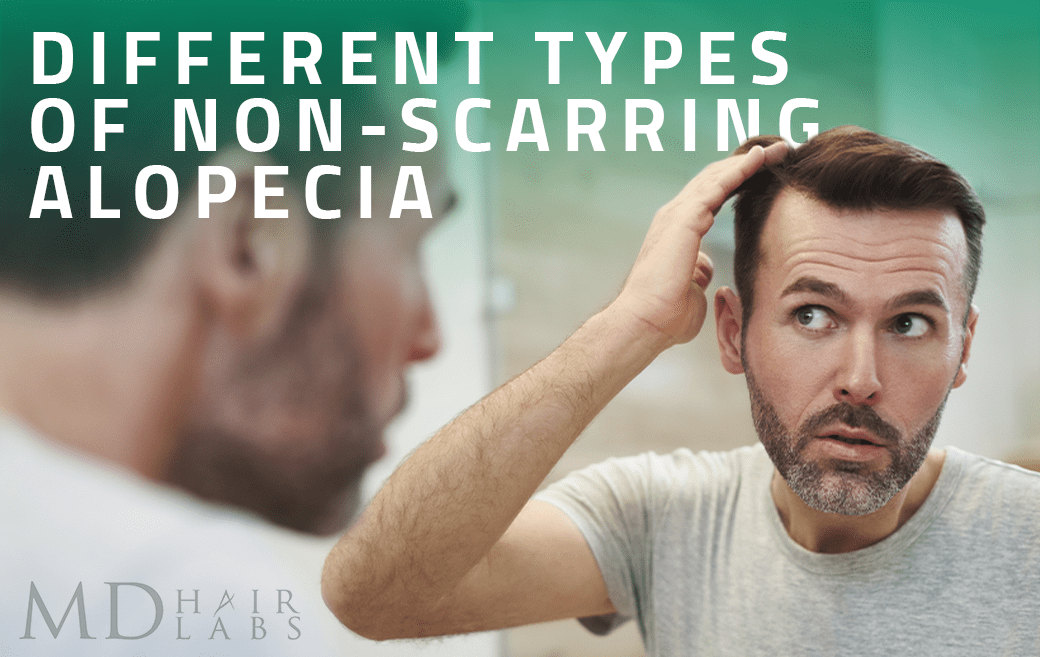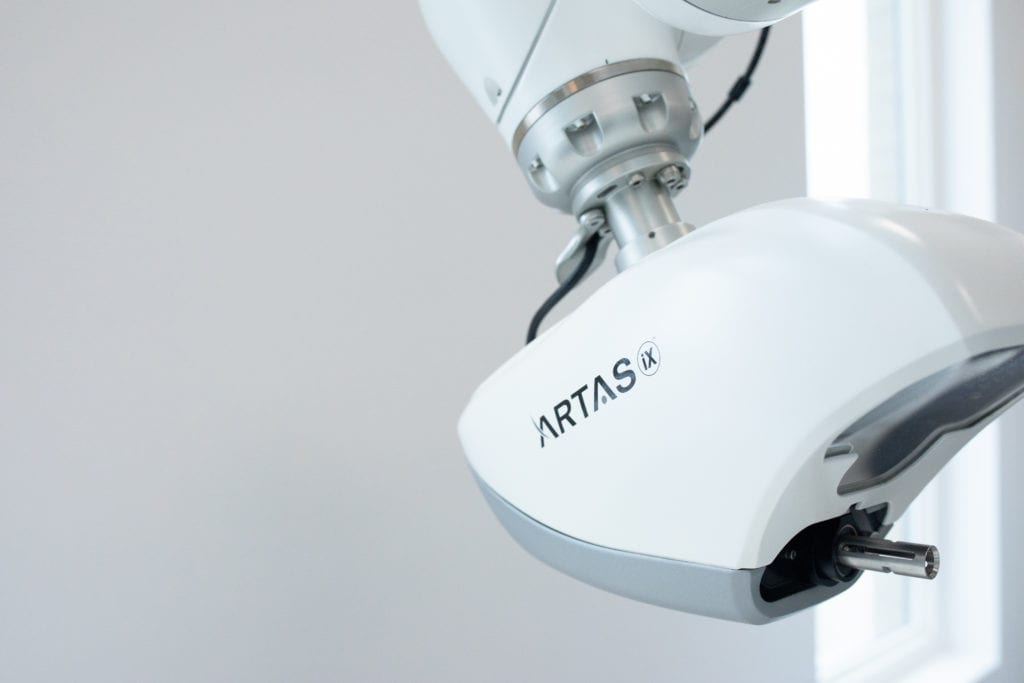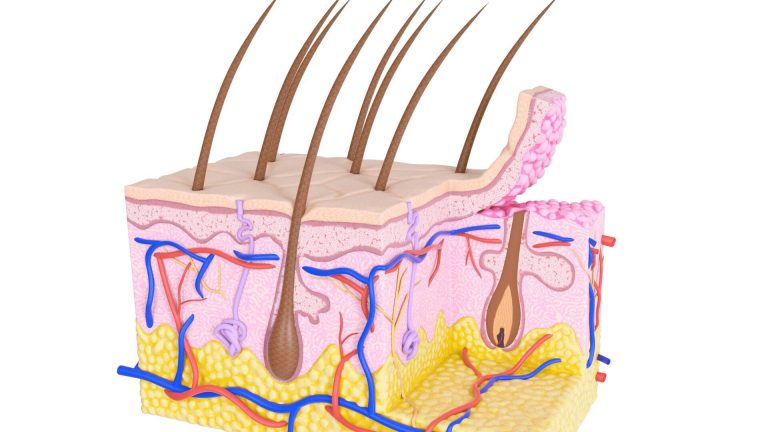
Different Types of Non-Scarring Alopecia
April 12, 2021 | Hair & Hair Loss
Different Types of Non-Scarring Alopecia
The non-scarring alopecias will be the focus of our first discussion. As a board-certified dermatologist, I have been treating disorders of hair and hair loss for over 15 years. Hair loss can be emotionally devastating and, in some cases permanently life-changing. We, at MD Hair Labs, are dedicated to diagnosing and treating hair loss both medically and with a hair transplant when necessary. Let’s dive into non-scarring alopecia.
Hair loss, or Alopecia, is extremely common and is generally divided into two overall types: scarring and non-scarring.
The non-scarring alopecias will be the focus of our first discussion and include:
- Androgenetic Alopecia
- Telogen Effluvium
- Anagen Effluvium
- Alopecia Areata
Those with non-scarring alopecia are candidates for medical management and in many cases hair transplant.

Androgenetic Alopecia
The most common type of non-scarring alopecia is Androgenetic Alopecia. Androgenetic Alopecia occurs in nearly 50% of men and women.
This type of hair loss is genetic and hormone-dependent. Those who have the genetic susceptibility for androgenetic alopecia usually begin to see hair loss in their 20’s and 30’s.
5-alpha-reductase
Those affected have an increased level of an enzyme (5-alpha-reductase) in the hair of the crown and frontal portions of the scalp. This enzyme converts testosterone to another hormone called DHT (Dihydrotestosterone). DHT causes the affected hair to become thinner and finer and eventually fall out.
Because the enzyme 5-alpha-reductase is not present in the hair at the back of the scalp, this hair does not fall out and can be a site of the donor’s hair for hair transplant. In men, the hair loss usually starts with regression of the frontal hairline that progresses posteriorly over time as well as thinning in the crown area. In women, the frontal hairline is usually spared at first and thinning is seen diffusely through the top of the scalp.
Medical Management
Medical management of Androgenetic Alopecia can in many cases significantly reduce or stop hair loss if started early and continued for maintenance. Medications containing finasteride, which blocks the enzyme 5-alpha-reductase, which is taken orally or can be applied topically, are imperative and must be continued long term.
Many other treatments have been proven to help prevent loss and regrow hair.
This includes platelet-rich plasma treatments, minoxidil (Rogaine) topically, and red-light laser therapy. Certain oral supplements can be used to increase hair and scalp health, and improve scalp blood flow as well. Each of these treatments will be discussed in-depth in future blogs.
When a significant amount of hair loss has already occurred, medical management will likely not lead to significant cosmetic improvement alone and a hair transplant may be necessary. Those considering a hair transplant must be committed to long-term medical management. This will keep the remaining hormone-sensitive hair and ensure the best outcome.
Telogen Effluvium (TE)
The second non-scarring alopecia we will discuss is telogen effluvium (TE). There are over 200,000 cases of TE per year in the US. TE can occur at any age and is caused by a shift of a large number of hairs in the growth (anagen) phase into the resting (telogen) phase. Because of this, there is extensive hair shedding diffusely across the scalp.
The most common causes are physical or mental stressors. Postpartum women often experience this condition 3-4 months after giving birth. TE can be caused by thyroid abnormalities, changes in hormone status (such as menopause), nutritional deficiencies, certain medications, as well as physical or emotional stressors.
Hair loss with telogen effluvium does not lead to total hair loss. Fortunately, the condition will stop before 50% of the hair is lost. In most cases, TE is completely reversible. With time and treatment of any underlying deficiency, or removal of the offending drug, hair loss stops and the hairs shift back into the anagen phase. This is what causes the hair to regrow.
Medical Management
This condition rarely becomes chronic and medical management, such as PRP, oral supplements, and topicals to improve hair health and strength can be used to help stop loss and regrow hair. Patients with TE rarely require a hair transplant. However, when TE has stabilized and medical management has failed to give the density the patient desires, a hair transplant could be considered.
Anagen Effluvium (AE)
The third type of non-scarring alopecia we will discuss is anagen effluvium. This type of hair loss occurs after radiation therapy to the head or systemic chemotherapy. Both radiation and certain chemotherapy drugs cause damage to the hairs in the active growth phase or anagen phase. This damage causes hair shaft abnormalities or atypically shaped hairs that are broken off or shed from the follicle. All hairs in the anagen phase are totally shed. Therefore 90% of the hair is completely lost.
Medical Management
Hair regrowth can occur after the cessation of radiation or chemotherapeutic agents. PRP therapy and supplementation can help the hair to regrow in density and strength as hair regrows. In some cases with high dose radiation or high dose chemotherapy, hair loss is permanent. These patients would be candidates for hair transplantation.

Alopecia Areata (AA)
The final type of non-scarring alopecia we will discuss is alopecia areata (AA).
This type of hair loss is an auto-immune disorder in which the person develops antibodies to their own hair follicles and areas of total hair loss appear on the scalp or other body areas.
This type of auto-immune disorder can be triggered by stressful situations. Often gray or white hair is spared. Historians believe that Joan of Arc had alopecia areata and this is why she, “ went Gray overnight.”
In AA, the patches of total loss can be extensive.
Total loss of all scalp hair is called Alopecia Totalis. Complete loss of all scalp and body hair is called Alopecia Universalis. These types of AA are often recalcitrant to treatment as is AA in the Ophiasis pattern, loss of the periphery of the scalp hair.
Medical Management
Other less severe types of AA are treated with immunosuppressive topical and intralesional injections and usually burn out over time leading to regrowth. For those with severe types of alopecia where the hair loss is permanent, a hair transplant could be considered once a loss has stabilized assuming there is enough donor hair to replace the loss. In many cases, hair prostheses or wigs may be necessary.
I will refer you to our other blogs discussing the scarring types of alopecia if you have further interest. We, at MD Hair Labs, encourage you to come in for a complimentary consultation and hair analysis to determine if medical management or a hair transplant would be an option for your hair loss.



